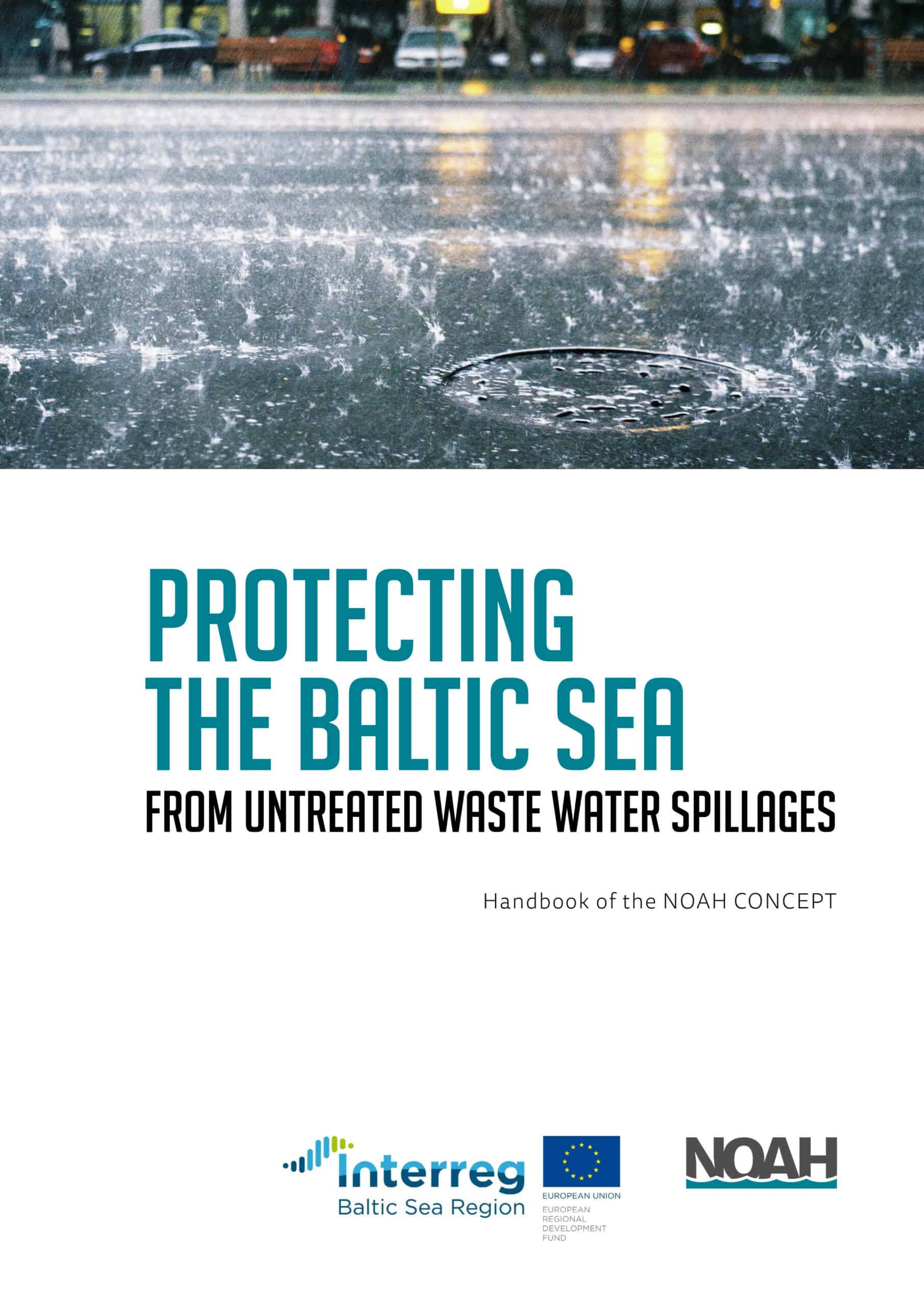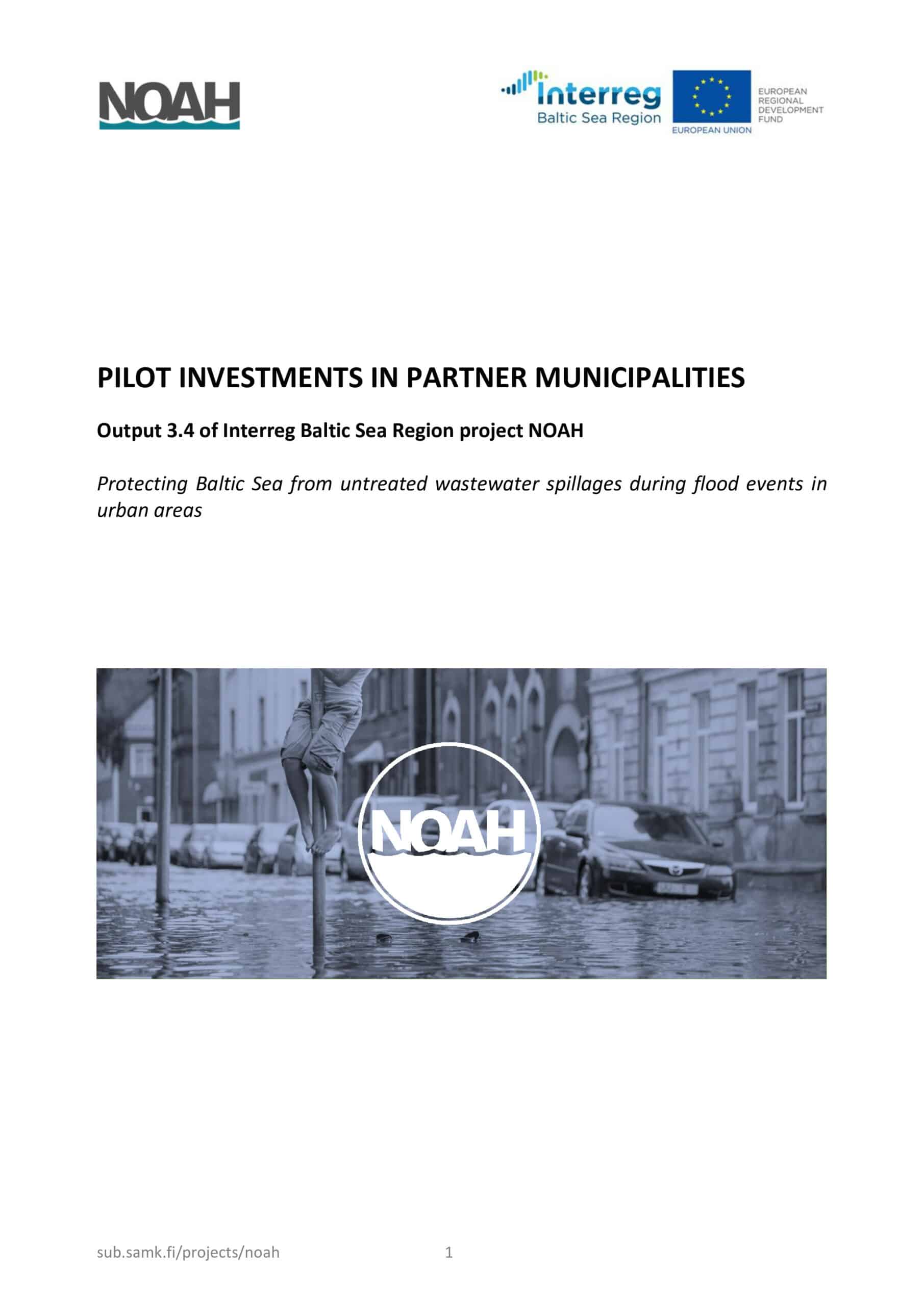NOAH
Floods bring pollutants to the Baltic Sea
Climate change brought along intense rainfalls and storms in the Baltic Sea region. Urban drainage systems were not capable to handle this, and therefore floods became more common in the densely populated areas. Floods raised the risk of flushing untreated wastewater from urban drainage systems into nature. This was harmful to people and environment due to the excessive amount of nutrients, hazardous substances and pathogenic microbes in wastewater.
Holistic planning and smart drainage systems
Urban areas needed to be prepared for floods by improved planning and self-adaptive drainage operations. The NOAH project brought together nine towns and water utilities, seven academic and research institutions and two umbrella organisations from six countries around the Baltic Sea to join their forces. NOAH’s approach was to create a concept for holistic planning and implement smart drainage systems in real urban environments. Holistic planning combines stormwater management with spatial planning. This is followed by development of smart drainage systems to make the existing facilities resilient to the impacts of climate change.
Budgets
in numbers
-
3.00MillionTotal
-
2.43MillionErdf
-
0.00MillionEni + Russia
-
0.00MillionNorway
Achievements
New concept to prevent and control urban floods
NOAH helped towns around the Baltic Sea mitigate the risks of floods and enhance climate resilience of their urban areas. By bringing together methods of stormwater management, spatial planning and real-time control of urban drainage systems in a holistic concept, the partners proposed steps for local municipality governments and water utilities on how to prevent and control urban floods. The concept included both passive measures targeted at modelling and monitoring, and active measures such as the modernisation of the existing infrastructure or the implementation of smart urban drainage. During the project, hundreds of experts from local city governments, water utilities and consultancy companies learned how to control floods and reduce the inflow of pollutants into the Baltic Sea.
Testing the concept in real urban environment across the Baltic Sea region
The partners tested the concept in eight pilot sites selected on the basis of their location near a natural water body (sea, river, channel) that was connected directly to the Baltic Sea. These were: Haapsalu and Rakvere in Estonia, Slupsk in Poland, Jurmala, Liepaja, and Ogre in Latvia, Söderhamn in Sweden, and Pori in Finland. After the analyses of flood risks in the selected urban areas, a few active measures were implemented across the partner towns. Automated hydrological stations installed in Jurmala, Liepaja, Ogre and Slupsk enabled to monitor the status of the stormwater system and make data driven decisions to reduce flood risks and related wash-off of toxins and hazardous substances to the Baltic Sea. Smart weirwall systems were installed in Rakvere and Haapsalu that made the urban drainage systems smarter and ensured flood risk reduction in the pilot areas. In Haapsalu the system automatically prevents water inflow from the sea to the drainage system in case of high sea levels. In Rakvere the smart weirwall restricts the water inflow to the town's main urban drainage system collector in case of heavy rainfalls and buffers the excess water at the upstream pond until the end of the rain event.
The partners also developed a new passive measure as part of their concept: they introduced an extreme weather layer in the city’s GIS. This helps planning specialists to consider and analyse the impact of various land use and soil types in the urban environment to simulate the response of the stormwater system and catchments to different rainfall events. As a result, the partner towns embedded the flood risk maps under different climate scenarios to the municipality’s urban planning procedures. Some towns implemented solutions to counteract these flood risks, using other funds than the Programme funding. For example, Söderhamn invested in a raingarden, and Slupsk started the investment into climate proofing the city.
The partners concluded that the average costs of the active and passive measures carried out in the project were about hundreds of thousand euros per pilot compared to millions that would have had to be invested in pipelines and tanks to increase the system’s capacity in a traditional way.
Outputs
Handbook on reducing the risk of pluvial floods in urban environments

Pilot investments in real-time control of urban drainage systems in six pilot sites

Project Stories
Partners
Tallinn University of Technology
- TownTallinn
- RegionPõhja-Eesti
- CountryEstonia
- RepresentativeIvar Annus
- Phone
- E-Mail
- Web
Satakunta University of Applied Sciences
- TownPori
- RegionSatakunta
- CountryFinland
- RepresentativeMinna Keinänen-Toivola
- Phone
- E-Mail
- Web
Gdansk University of Technology
- TownGdańsk
- RegionTrójmiejski
- CountryPoland
- RepresentativeKatarzyna Kołecka
- Phone
- E-Mail
- Web
City of Haapsalu
- TownHaapsalu
- RegionLääne-Eesti
- CountryEstonia
- RepresentativePeeter Vikman
- Phone
- E-Mail
- Web
City of Rakvere
- TownRakvere
- RegionKesk-Eesti
- CountryEstonia
- RepresentativeNeeme-Jaak Paap
- Phone
- E-Mail
- Web
Liepaja municipal authority "Komunālā pārvalde"
- TownLiepaja
- RegionKurzeme
- CountryLatvia
- RepresentativeEgils Muižulis
- Phone
- E-Mail
- Web
Natural Resources Institute Finland (Luke)
- TownHelsinki
- RegionHelsinki-Uusimaa
- CountryFinland
- RepresentativeKati Räsänen
- Phone
- E-Mail
- Web
Estonian Waterworks Association
- TownTallinn
- RegionPõhja-Eesti
- CountryEstonia
- RepresentativeIrina Vahtra
- Phone
- E-Mail
- Web
City of Pori
- TownPori
- RegionSatakunta
- CountryFinland
- RepresentativePekka Vuola
- Phone
- E-Mail
- Web
Halmstad University
- TownHalmstad
- RegionHallands län
- CountrySweden
- RepresentativeAgnieszka Hunka
- Phone
- E-Mail
- Web
Economic Chamber Polish Waterworks
- TownBydgoszcz
- RegionBydgosko-Toruński
- CountryPoland
- RepresentativeKlara Ramm
- Phone
- E-Mail
- Web
Riga Technical University
- TownRiga
- RegionRīga
- CountryLatvia
- RepresentativeJanis Rubulis
- Phone
- E-Mail
- Web
Ogre municipality
- TownOgre
- RegionPierīga
- CountryLatvia
- RepresentativeEdgars Pārpucis
- Phone
- E-Mail
- Web
Slupsk Water Supply
- TownSlupsk
- RegionSłupski
- CountryPoland
- RepresentativeREMIGIUSZ ŁYSZYK
- Phone
- E-Mail
- Web
Technical University of Denmark
- TownKgs Lyngby
- RegionKøbenhavns omegn
- CountryDenmark
- RepresentativeMorten Borup
- Phone
- E-Mail
- Web
Jurmalas udens Ltd
- TownJurmala
- RegionPierīga
- CountryLatvia
- RepresentativeAivars Kamaruts
- Phone
- E-Mail
- Web
The municipality of Söderhamn
- TownSöderhamn
- RegionGävleborgs län
- CountrySweden
- RepresentativeIngemar Olofsson
- Phone
- E-Mail
- Web
Rakvere Water Company
- TownRakvere
- RegionKirde-Eesti
- CountryEstonia
- RepresentativeUrmas Krikk
- Phone
- E-Mail
- Web
-
Project managerIvar AnnusTallinn University of Technology
-
Legal representativeMaia-Liisa AntonTallinn University of Technology
-
Financial managerLiina KotkasTallinn University of Technology
-
Communication managerHanna RissanenSatakunta University of Applied Sciences



